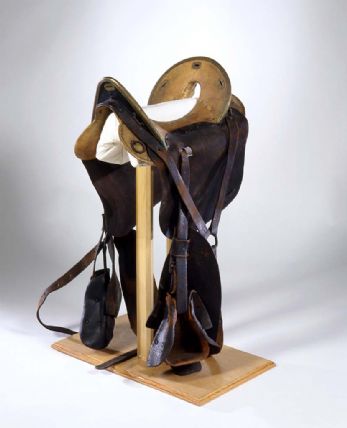As COVID-19 deaths spiked in 2020, Suzanne Firstenberg’s public art installation "In America: How could this happen…"
Museum Artifacts

Grade Range:
5-12
Resource Type(s):
Artifacts, Primary Sources
Date Posted:
12/15/2010
The halberd was a versatile pole arm developed as an infantry weapon in the 13th century. It has an ax-like blade and a steel spike mounted on the end of a long shaft. By the time of the Seven Years War it was carried by sergeants as a symbol of rank and authority.

Grade Range:
5-12
Resource Type(s):
Artifacts, Primary Sources
Date Posted:
12/30/2010
On February 16, 1862, General Buckner surrendered Fort Donelson. The unconditional surrender created jubilation throughout the North and shock in Dixie. It was the North’s first major victory of the Civil War, opening the way into the very heart of the Confederacy.

Grade Range:
5-12
Resource Type(s):
Artifacts, Primary Sources
Date Posted:
12/28/2010
Cap worn by Landsman Nathan Ives of the USS Kearsarge.
The CSS Alabama was a 1,050-ton screw steam sloop of war. Built in Liverpool, England, it took to sea as a merchant ship, but on August 24, 1862, it rendezvoused with a supply ship and was outfitted for war. For th

Grade Range:
5-12
Resource Type(s):
Artifacts, Primary Sources
Date Posted:
12/29/2010
Service jacket and cap worn by Rear Admiral David G. Farragut while directing the fire of the flagship Hartford during the Battle of Mobile Bay on August 5, 1864. It was during the Battle of Mobile Bay that Farragut uttered the infamous words, “Damn the torpedoes! Full speed ahead.”

Grade Range:
5-12
Resource Type(s):
Artifacts, Primary Sources
Date Posted:
6/11/2009
This is the fourth object in the Roosevelt/Saint-Gaudens object group.
Someone once observed that a giraffe was a horse designed by a committee. The same might be said of this coin: what had seemed a good idea around a table in the boardroom proved to be a

Grade Range:
5-12
Resource Type(s):
Artifacts, Primary Sources
Date Posted:
9/1/2010
This crumpled piece of exterior sheathing was recovered from the debris pile of the World Trade Center after the building collapsed following the terrorist attacks of September 11, 2001.

Grade Range:
5-12
Resource Type(s):
Artifacts, Primary Sources
Date Posted:
12/17/2010
In 1855 Secretary of War Jefferson Davis was instrumental in the creation of two regiments of cavalry. It was recommended that the cavalry have a distinctive hat; it is sometimes called the Jeff Davis hat. It also was referred to as the Hardee hat, after William Joseph Hardee, an officer of the 2

Grade Range:
5-12
Resource Type(s):
Artifacts, Primary Sources
Date Posted:
12/28/2010
The LeMat revolver was a favorite of famous high-ranking Confederate officers, such as J. E. B. Stuart.

Grade Range:
5-12
Resource Type(s):
Artifacts, Primary Sources
Date Posted:
12/23/2010
On April 21, 1861, Virginians claimed an abandoned navy yard at Norfolk, Virginia. There they found the sunken hull of the burned USS Merrimack. The Merrimack was raised and on June 23, 1861 the Honorable S. R. Mallory, Confederate secretary of the navy, ordered it to be converted to an ironclad.

Grade Range:
5-12
Resource Type(s):
Artifacts, Primary Sources
Date Posted:
12/17/2010
Captain George B. McClellan toured Europe with a military commission looking at new military tactics. He returned and developed a new modified cavalry saddle. In 1859, the U.S. War Department adopted the McClellan saddle. They remained the standard issue throughout the history of the horse cavalr



















